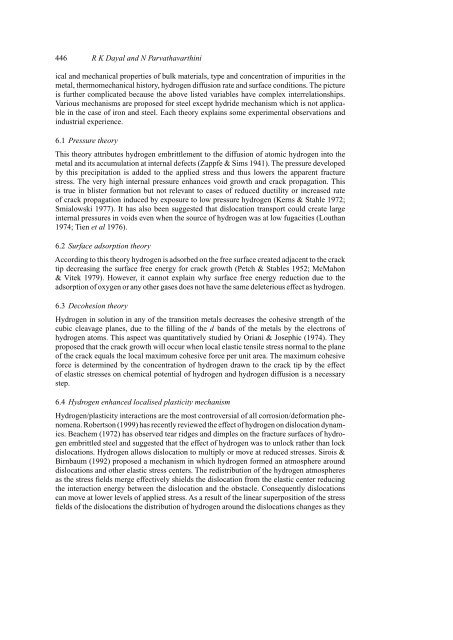Hydrogen embrittlement in power plant steels - Indian Academy of ...
Hydrogen embrittlement in power plant steels - Indian Academy of ...
Hydrogen embrittlement in power plant steels - Indian Academy of ...
Create successful ePaper yourself
Turn your PDF publications into a flip-book with our unique Google optimized e-Paper software.
446 R K Dayal and N Parvathavarth<strong>in</strong>i<br />
ical and mechanical properties <strong>of</strong> bulk materials, type and concentration <strong>of</strong> impurities <strong>in</strong> the<br />
metal, thermomechanical history, hydrogen diffusion rate and surface conditions. The picture<br />
is further complicated because the above listed variables have complex <strong>in</strong>terrelationships.<br />
Various mechanisms are proposed for steel except hydride mechanism which is not applicable<br />
<strong>in</strong> the case <strong>of</strong> iron and steel. Each theory expla<strong>in</strong>s some experimental observations and<br />
<strong>in</strong>dustrial experience.<br />
6.1 Pressure theory<br />
This theory attributes hydrogen <strong>embrittlement</strong> to the diffusion <strong>of</strong> atomic hydrogen <strong>in</strong>to the<br />
metal and its accumulation at <strong>in</strong>ternal defects (Zappfe & Sims 1941). The pressure developed<br />
by this precipitation is added to the applied stress and thus lowers the apparent fracture<br />
stress. The very high <strong>in</strong>ternal pressure enhances void growth and crack propagation. This<br />
is true <strong>in</strong> blister formation but not relevant to cases <strong>of</strong> reduced ductility or <strong>in</strong>creased rate<br />
<strong>of</strong> crack propagation <strong>in</strong>duced by exposure to low pressure hydrogen (Kerns & Stahle 1972;<br />
Smialowski 1977). It has also been suggested that dislocation transport could create large<br />
<strong>in</strong>ternal pressures <strong>in</strong> voids even when the source <strong>of</strong> hydrogen was at low fugacities (Louthan<br />
1974; Tien et al 1976).<br />
6.2 Surface adsorption theory<br />
Accord<strong>in</strong>g to this theory hydrogen is adsorbed on the free surface created adjacent to the crack<br />
tip decreas<strong>in</strong>g the surface free energy for crack growth (Petch & Stables 1952; McMahon<br />
& Vitek 1979). However, it cannot expla<strong>in</strong> why surface free energy reduction due to the<br />
adsorption <strong>of</strong> oxygen or any other gases does not have the same deleterious effect as hydrogen.<br />
6.3 Decohesion theory<br />
<strong>Hydrogen</strong> <strong>in</strong> solution <strong>in</strong> any <strong>of</strong> the transition metals decreases the cohesive strength <strong>of</strong> the<br />
cubic cleavage planes, due to the fill<strong>in</strong>g <strong>of</strong> the d bands <strong>of</strong> the metals by the electrons <strong>of</strong><br />
hydrogen atoms. This aspect was quantitatively studied by Oriani & Josephic (1974). They<br />
proposed that the crack growth will occur when local elastic tensile stress normal to the plane<br />
<strong>of</strong> the crack equals the local maximum cohesive force per unit area. The maximum cohesive<br />
force is determ<strong>in</strong>ed by the concentration <strong>of</strong> hydrogen drawn to the crack tip by the effect<br />
<strong>of</strong> elastic stresses on chemical potential <strong>of</strong> hydrogen and hydrogen diffusion is a necessary<br />
step.<br />
6.4 <strong>Hydrogen</strong> enhanced localised plasticity mechanism<br />
<strong>Hydrogen</strong>/plasticity <strong>in</strong>teractions are the most controversial <strong>of</strong> all corrosion/deformation phenomena.<br />
Robertson (1999) has recently reviewed the effect <strong>of</strong> hydrogen on dislocation dynamics.<br />
Beachem (1972) has observed tear ridges and dimples on the fracture surfaces <strong>of</strong> hydrogen<br />
embrittled steel and suggested that the effect <strong>of</strong> hydrogen was to unlock rather than lock<br />
dislocations. <strong>Hydrogen</strong> allows dislocation to multiply or move at reduced stresses. Sirois &<br />
Birnbaum (1992) proposed a mechanism <strong>in</strong> which hydrogen formed an atmosphere around<br />
dislocations and other elastic stress centers. The redistribution <strong>of</strong> the hydrogen atmospheres<br />
as the stress fields merge effectively shields the dislocation from the elastic center reduc<strong>in</strong>g<br />
the <strong>in</strong>teraction energy between the dislocation and the obstacle. Consequently dislocations<br />
can move at lower levels <strong>of</strong> applied stress. As a result <strong>of</strong> the l<strong>in</strong>ear superposition <strong>of</strong> the stress<br />
fields <strong>of</strong> the dislocations the distribution <strong>of</strong> hydrogen around the dislocations changes as they
















